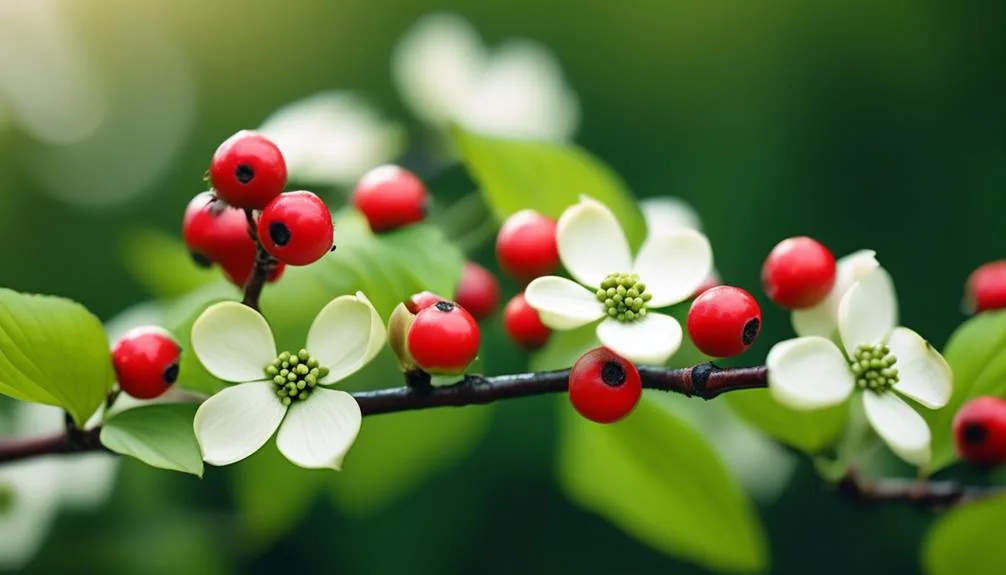Ever wondered why dogwood trees have berries? Some think they're a defense mechanism, while others believe they attract pollinators. But the truth might surprise you.
Understanding why dogwood trees produce berries can reveal fascinating insights into their role in nature.
Exploring this relationship can provide a deeper understanding of the ecological significance behind this natural occurrence.
Dogwood Tree Species That Produce Berries
Dogwood trees that produce berries are a delightful addition to any garden, adding both visual appeal and providing a valuable food source for wildlife. These trees aren't only a treat for the eyes but also attract a variety of birds, making them a popular choice for bird enthusiasts. The berries serve as a crucial food source for many bird species, enhancing the biodiversity of your garden.
From robins to cardinals, these berries are a magnet for a wide array of feathered visitors, adding an element of liveliness to your outdoor space. Landscaping benefits are abundant with these berry-producing dogwood trees, as they offer an attractive focal point while supporting local wildlife.
Whether you're an avid bird watcher or simply enjoy a vibrant garden, these trees are a must-have for any landscape.
Conditions Required for Dogwood Berry Production
Nurturing the optimal growing conditions for your berry-producing dogwood trees ensures a plentiful harvest of vibrant berries, drawing in a diverse array of bird species and enriching the biodiversity of your garden.
To ensure successful berry production, environmental conditions such as sunlight, soil quality, and pollination are crucial. Dogwood trees thrive in well-drained, acidic soils with a pH level between 5.5 and 6.5. They prefer partial shade, especially in hotter climates, to protect the flowers from scorching. Adequate sunlight is essential for photosynthesis and the subsequent development of berries.
Additionally, cross-pollination between dogwood trees greatly enhances berry production. Consider planting different varieties of dogwood trees to facilitate cross-pollination and increase the chances of bountiful berry yields.
Role of Berries in Dogwood Tree Reproduction
The vibrant berries of the dogwood tree play a crucial role in the reproduction and propagation of this beloved ornamental species. Dogwood trees produce these attractive berries as part of their fruit development process. The berries serve as a vital food source for various bird species, attracting them to the tree.
When birds consume the berries, they aid in the dispersal of the dogwood tree's seeds, contributing to the tree's reproduction and growth in new areas. Additionally, the pollination process, facilitated by insects such as bees and butterflies attracted to the dogwood's flowers, is essential for the formation of these berries.
This intricate relationship between the tree, its berries, and the surrounding wildlife highlights the significant role that the berries play in the dogwood tree's reproduction and ecological impact.
Factors Influencing Dogwood Berry Color and Size
In exploring the factors that influence dogwood berry color and size, it becomes evident how these attributes are intricately linked to the tree's reproductive success and its ecological impact. Berry color genetics play a crucial role in determining the color variations seen in dogwood berries. Environmental influences such as temperature, sunlight, and soil composition also affect berry size and color. Below is a table summarizing some of the key factors that influence dogwood berry color and size:
| Factors | Influence |
|---|---|
| Berry Color Genetics | Determine the range of colors in berries |
| Temperature | Affects ripening and color intensity |
| Sunlight | Can impact color vibrancy and size |
| Soil Composition | Influences nutrient availability for growth |
| Pest Presence | May cause discoloration or damage |
Understanding these factors is essential for comprehending the diversity of dogwood berries and their role in the ecosystem.
Human and Wildlife Interaction With Dogwood Berries
Interacting with dogwood berries can provide a fascinating insight into the dynamic relationship between humans, wildlife, and the natural environment.
The bright red or white berries of the dogwood tree aren't just visually appealing; they also play a crucial role in the ecosystem. Birds are particularly drawn to these berries, using them as a vital food source, especially during the winter months when other food may be scarce. The berries are rich in fat and provide essential nutrients for many bird species.
Additionally, humans can also interact with dogwood berries, as they're edible for people too. While they aren't commonly consumed, some people use them in jams or jellies. However, it's important to note that not all species of dogwood berries are safe for human consumption, so caution should be exercised.
Conclusion
In appreciating the vibrant dogwood berries, we witness nature's intricate web of relationships. Reproduction and wildlife sustenance intertwine as the beauty of these berries serves a vital purpose. They remind us of the interconnectedness between dogwood trees, wildlife, and ourselves.

My interest in trees started when I first saw the giant sequoias in Yosemite.
I was a teenager then, and I remember thinking, “I need to learn more about this.”
That moment stuck with me.
A few years later, I went on to study forestry at Michigan Tech.
Since graduating, I’ve worked in a mix of hands-on tree care and community education.
I’ve spent over ten years helping people understand how to plant, maintain, and protect the trees in their neighborhoods.
I don’t see trees as just part of the landscape.
They are living things that make a real difference in our daily lives.
